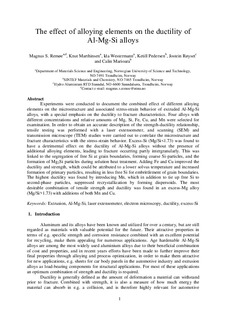| dc.contributor.author | Remøe, Magnus Sætersdal | |
| dc.contributor.author | Marthinsen, Knut | |
| dc.contributor.author | Westermann, Ida | |
| dc.contributor.author | Pedersen, Ketill Olav | |
| dc.contributor.author | Røyset, Jostein | |
| dc.contributor.author | Marioara, Calin Daniel | |
| dc.date.accessioned | 2017-10-03T08:56:40Z | |
| dc.date.available | 2017-10-03T08:56:40Z | |
| dc.date.created | 2017-03-30T11:44:44Z | |
| dc.date.issued | 2017 | |
| dc.identifier.citation | Materials Science & Engineering: A. 2017, 693 60-72. | nb_NO |
| dc.identifier.issn | 0921-5093 | |
| dc.identifier.uri | http://hdl.handle.net/11250/2457978 | |
| dc.description.abstract | Experiments were conducted to document the combined effect of different alloying elements on the microstructure and associated stress-strain behavior of extruded Al-Mg-Si alloys, with a special emphasis on the ductility to fracture characteristics. Four alloys with different concentrations and relative amounts of Mg, Si, Fe, Cu, and Mn were selected for examination. In order to obtain an accurate description of the strengthductility relationship, tensile testing was performed with a laser extensometer, and scanning (SEM) and transmission microscope (TEM) studies were carried out to correlate the microstructure and fracture characteristics with the stress-strain behavior. Excess-Si (Mg/Si < 1.73) was found to have a detrimental effect on the ductility of Al-Mg-Si alloys without the presence of additional alloying elements, leading to fracture occurring partly intergranularly. This was linked to the segregation of free Si at grain boundaries, forming coarse Si-particles, and the formation of Mg2Si particles during solution heat treatment. Adding Fe and Cu improved the ductility and strength, which could be attributed to a lower solvus temperature and increased formation of primary particles, resulting in less free Si for embrittlement of grain boundaries. The highest ductility was found by introducing Mn, which in addition to tie up free Si to second-phase particles, suppressed recrystallization by forming dispersoids. The most desirable combination of tensile strength and ductility was found in an excess-Mg alloy (Mg/Si > 1.73) with additions of both Mn and Cu. | nb_NO |
| dc.language.iso | eng | nb_NO |
| dc.publisher | Elsevier | nb_NO |
| dc.rights | Attribution-NonCommercial-NoDerivatives 4.0 Internasjonal | * |
| dc.rights.uri | http://creativecommons.org/licenses/by-nc-nd/4.0/deed.no | * |
| dc.title | The effect of alloying elements on the ductility of Al-Mg-Si alloys | nb_NO |
| dc.type | Journal article | nb_NO |
| dc.type | Peer reviewed | nb_NO |
| dc.description.version | acceptedVersion | nb_NO |
| dc.source.pagenumber | 60-72 | nb_NO |
| dc.source.volume | 693 | nb_NO |
| dc.source.journal | Materials Science & Engineering: A | nb_NO |
| dc.identifier.doi | 10.1016/j.msea.2017.03.078 | |
| dc.identifier.cristin | 1462342 | |
| dc.relation.project | Norges forskningsråd: 219371 | nb_NO |
| dc.description.localcode | © 2017. This is the authors’ accepted and refereed manuscript to the article. LOCKED until 23.3.2019 due to copyright restrictions. This manuscript version is made available under the CC-BY-NC-ND 4.0 license http://creativecommons.org/licenses/by-nc-nd/4.0/ | nb_NO |
| cristin.unitcode | 194,66,35,0 | |
| cristin.unitname | Institutt for materialteknologi | |
| cristin.ispublished | true | |
| cristin.fulltext | original | |
| cristin.qualitycode | 2 | |

